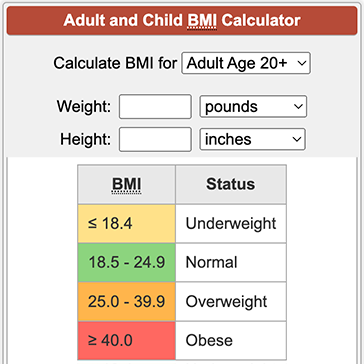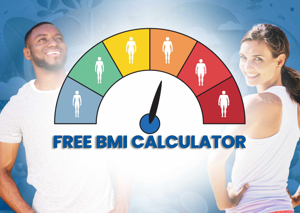A free BMI calculator is a helpful tool for quickly assessing your body mass index. BMI is a measure that uses your height and weight to work out if your weight is healthy.
By using a free BMI calculator, you can easily determine if you’re in a healthy weight range for your height.
Many people find BMI calculators useful for tracking their weight over time.
It’s important to note that while BMI is a good starting point, it doesn’t tell the whole story about your health. Factors like muscle mass, age, and gender can affect how accurate BMI is for individuals.
We recommend using a BMI calculator as part of a broader approach to health. Regular check-ups with your doctor, a balanced diet, and consistent exercise are all key components of maintaining a healthy weight and lifestyle.

Key Takeaways
- BMI calculators provide a quick way to assess if your weight is healthy for your height
- Regular use of BMI calculators can help track weight changes over time
- BMI should be used alongside other health measures for a complete picture of wellness
Understanding BMI
Body Mass Index (BMI) is a widely used tool to assess body composition and health risks. It provides a simple way to estimate body fat based on height and weight measurements.
History and Development of BMI
BMI was created in the 1830s by Belgian mathematician Adolphe Quetelet. He noticed that weight tends to increase as the square of height in adults with normal body frames. This observation led to the development of the Quetelet Index, which later became known as BMI.
In the 1970s, researcher Ancel Keys popularized BMI for population studies. He found it was the best proxy for body fat percentage among various ratios of weight and height.
The World Health Organization (WHO) adopted BMI as a standard measure in the 1980s. This helped establish consistent categories for underweight, normal weight, overweight, and obesity.
BMI Calculation Formula
The BMI formula is simple:
BMI = weight (kg) / height² (m²)
For imperial units:
BMI = 703 × weight (lbs) / height² (inches²)
Many online calculators can quickly compute BMI. These tools often provide instant results and categorization.
To calculate manually:
- Convert height to meters or inches
- Square the height
- Divide weight by the squared height
- Multiply by 703 if using imperial units
Interpreting BMI Results
BMI categories for adults are:
- Underweight: Below 18.5
- Normal weight: 18.5 to 24.9
- Overweight: 25 to 29.9
- Obese: 30 or greater
These ranges apply to adults 20 years and older. Children and teens use different charts based on age and sex.
It’s important to note that BMI has limitations. It doesn’t distinguish between muscle and fat mass. Athletes or muscular individuals may have high BMIs without excess body fat.
BMI also doesn’t account for fat distribution. Abdominal fat carries more health risks than fat in other areas. Despite these limitations, BMI remains a useful screening tool for most of the population.
Benefits of Using a Free BMI Calculator
Free BMI calculators offer several advantages for people looking to assess their health. These tools provide quick insights into body composition without cost or hassle.
Accessibility and Convenience
Free BMI calculators are easily accessible online. We can use them anytime, anywhere with an internet connection. This convenience allows for regular BMI checks without visiting a doctor’s office.
Many websites and apps offer these calculators at no charge. Users only need to input their height and weight to get results. This simplicity makes BMI tracking a breeze for people of all ages and tech skills.
BMI calculator tools often include helpful features. Some provide weight ranges for different BMI categories. Others may offer personalized health tips based on results.
Immediate Results
Free BMI calculators deliver instant feedback. We enter our measurements and receive our BMI score right away. This quick turnaround helps us make timely decisions about our health.
The immediacy allows for frequent monitoring of BMI changes. We can track how diet and exercise affect our body composition over time. This real-time data empowers us to adjust our lifestyle habits as needed.
Many calculators also explain what our BMI means. They often provide context about healthy ranges and potential health risks. This immediate education helps us understand our results better.
Privacy and Confidentiality
Using a free online BMI calculator ensures privacy. We can check our BMI without sharing personal information with others. This discretion is valuable for those who feel self-conscious about their weight.
There’s no need to discuss results with a healthcare provider unless we choose to. We control who sees our information and when. This confidentiality encourages regular self-monitoring without fear of judgment.
Many BMI calculator websites prioritize user privacy. They often don’t store personal data or require account creation. This approach protects our sensitive health information from potential breaches.
Limitations of BMI Calculators
BMI calculators have some key drawbacks that limit their accuracy and usefulness. They don’t account for important factors like body composition and can lead to wrong conclusions about health.
Factors BMI Does Not Account For
BMI calculators only use height and weight, missing other important body measures. They don’t consider muscle mass, bone density, or fat distribution. This means a very fit athlete could be labeled as overweight due to muscle weight.
BMI also ignores age and sex differences. As we age, we tend to lose muscle and gain fat, even if our weight stays the same. Men and women have different typical body compositions too.
Body shape matters for health risks, but BMI ignores this. People who carry fat around their waist face higher risks than those with fat in their hips and thighs.
BMI Misinterpretations and Misuse
BMI results can be misunderstood or misused. Some people wrongly think BMI directly measures body fat or health. But it’s just a rough guide based on averages.
Using BMI alone to judge health can lead to wrong conclusions. A person with a “normal” BMI might still have unhealthy fat levels. Or someone in the “overweight” range could be healthy.
We should be careful about using BMI for individuals. It works better for studying large groups. For personal health, other tests like body fat percentage or waist size can give a fuller picture.
Frequently Asked Questions
Body Mass Index (BMI) is a helpful tool for assessing weight status. We’ve compiled answers to common questions about calculating and interpreting BMI.
How can one calculate Body Mass Index (BMI) without any cost?
There are many free BMI calculators available online. The Centers for Disease Control and Prevention (CDC) offers a free calculator on their website. You can also calculate BMI manually using a simple formula.
What is the process to determine BMI using kilograms (kg) as a unit of measure?
To calculate BMI using metric units, divide weight in kilograms by height in meters squared. The formula is BMI = weight (kg) / (height (m))^2.
Is there an age-specific Body Mass Index calculation method available without charge?
Yes, the CDC provides free BMI calculators for different age groups. There’s a specific calculator for children and teens aged 2-19 years, and another for adults 20 years and older.
What constitutes a normal BMI range for adult individuals?
For adults, a BMI between 18.5 and 24.9 is generally considered normal. BMIs below 18.5 are underweight, 25-29.9 are overweight, and 30 or above are obese.
How can BMI be accurately calculated for a 70-year-old?
We use the same BMI calculation method for all adults, including those over 70. The CDC’s Adult BMI Calculator can be used for anyone 20 years and older.
Are there differences in BMI calculations for males and females, and if so, what are they?
The basic BMI formula is the same for both males and females. However, interpretation of BMI can differ between sexes due to differences in body composition.

